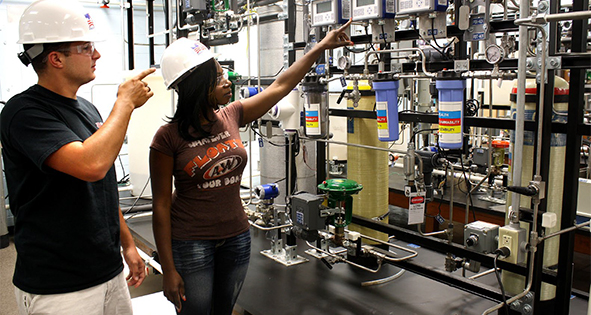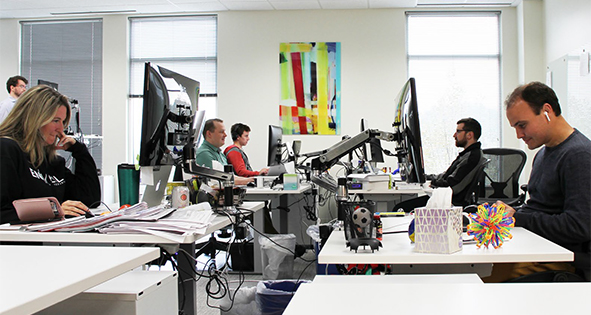
Illinois: Turnaround in Progress
19 Sep, 2016
By Lori Culpepper
Illinois has the fifth largest economy in the United States, making it the 19th largest in the world due partly to its transportation and logistics network, including one of the largest interstate networks in the world. The state is also one of the biggest producers of agricultural products.
It is a state of creation and innovation, producing 96 Nobel Prize winners, 200 institutions of higher education and the home to the premier national laboratory for particle physics and accelerator research. More than 400 major corporations are headquartered in Illinois, along with 1,800 foreign-based companies. There are 13 technology parks and 87 incubators and accelerators to help grow businesses.
Governor Bruce Rauner says Illinois continues to battle several challenges related to their economy, including the fact that it has been split in two: one part with modest growth, the other in decline. Because of access to global transportation infrastructure, first class universities and world class cultural amenities, white-collar communities in the Chicago area have mostly been able to overcome the financial mismanagement that continues to be a problem in Chicago and Cook County.
The state has one of the highest property tax rates in the U.S., which is one reason people are leaving the state to work elsewhere. In recent years, the state has lost 300,000 jobs to neighboring states, such as Texas, Indiana and Wisconsin for manufacturing jobs.
Rauner says that to bring good jobs to Illinois, they have to make Illinois a place where it is good to do business. To do this, he has plan to change these issues for the better with this “Turnaround Agenda” that involves workers comp reform, better labor regulations, lesser liability costs and lower property taxes. He also plans to tackle criminal justice reform and has a ten point plan for education funding, including more funding for K-12 and more local control for districts.
Another challenging area Rauner says is holding the state back is the antiquated information technology system that is inefficient and ineffective. Currently, Illinois ranks among the three highest spending states on IT, but it is one of the worst states for digital services delivered to the public. The new Department of Innovation and Technology will allow the state to consolidate, modernize and streamline IT systems.
As is often the case, Rauner says the key to raising family incomes, bringing in more high paying jobs and allowing a better life for everyone in Illinois is to have a high quality, fully-integrated education system. This involves early education to K-12, community colleges and universities and a coordinated job training and technical training program.
The state has several long-term goals to accomplish this, including significantly increasing state support for education, providing proper funding for early childhood education, and supporting partnerships between high schools, community colleges and local employers. State officials also want to empower universities and community colleges to reduce administrative costs, work rules, pension liabilities and unfunded mandates, while still offering additional financial support to those schools that show real progress in putting more resources in the classroom.
Village of Schaumburg
By Rachel Hamilton
The Village of Schaumburg is in the Chicago Metropolitan Area, located at the intersection of Interstates 90 and 290 about eight miles from O’Hare International Airport.
“We’ve got two major projects that are leading the way,” says Matt Frank, assistant director of community development and economic development manager for the Village of Schaumburg.
One project is the relocation of the Sunstar Americas Inc. headquarters from Chicago to Schaumburg which opened in spring 2016. It represents a roughly $55 million investment, and the 300,000 square foot facility is built on 35 of 70 total acres, according to Frank.
The second project is Zurich Insurance Group’s new North American headquarters. Zurich expects the 700,000 square foot facility to be finished by the end of 2016. It represents a $300 million investment and keeps 2,500 jobs in Schaumburg.
“We used our TIF funds to help incentivize them and keep them in the area,” Frank says, noting that they will also offer job training funds and tax credits from the state. Schaumburg’s Tax Increment Financing District is located in the northeast corner of the village along Interstate 90.
Schaumburg is also part of the Golden Corridor Advanced Manufacturing Partnership. “We’re working with our high schools and local community colleges to raise awareness among students of careers in manufacturing and high tech,” Franks says.
The communities in the partnership contribute funds for programming that help students learn more about industry and tech-related careers, he explains. The partnership has been going for more than five years, “and we’ve seen tangible results of thousands of kids going through these programs,” says Frank.
“We tout ourselves as the second largest economic center in the state of Illinois,” he adds. Schaumburg has around 34 million square feet of commercial, industrial and office space.
Village of Arlington Heights
By Rachel Hamilton
The Village of Arlington Heights is in the Chicago Metropolitan Area just north of Interstate 90, about 15 minutes from O’Hare International Airport and 10 minutes from Chicago Executive Airport.
An important project in the village has been Arlington Downs, a $250 million mixed use project on about 30 acres of land, says Michael Mertes, business development coordinator for the Department of Planning and Community Development at the Village of Arlington Heights.
When finished, Arlington Downs will include two upscale residential buildings, a 160-room hotel, a renovated and expanded waterpark and more than 100,000 square feet of restaurants and retail entertainment space, Mertes says.
“Another important contributor to our economy is HSBC,” he adds. The London-based financial services company is relocating its North American headquarters to Arlington Heights.
Location is significant to the village’s success. “We’ve got immediate proximity to three interstates,” Mertes says. Those include Interstates 90, 290 and 355. “We’ve also got opportunities for rail.” The village is also “about a 40 minute drive from downtown Chicago.”
On the south end of the village, Interstate 90 is being expanded to allow 80,000 more vehicles per day, according to Mertes. There are also two metro train stations in the village.
The economy in Arlington Heights is diverse with “a strong balance of commercial and industrial,” says Mertes. He notes that HSBC and AT&T are in the village, and “over 15 new office businesses this year relocated into Arlington Heights.”
“Arlington Heights high school students attend six of the state’s top 50 public high schools according to U.S. News and World Report,” he says, adding that more than half of the residents 25 and older have at least a bachelor’s degree.
Robert Morris College and ITT Institute opened satellites in 2013 in Arlington Heights, Mertes says. The village is additionally served by Harper Community College and its Small Business Development Center.
DuPage County
By Rachel Hamilton
Besides the expected tasks of economic development, Choose DuPage Economic Development Alliance in DuPage County is working on four general areas, according to John Carpenter, president and CEO.
First, the western portion of O’Hare International airport is inside the county. Efforts here are focused on getting more access to the airport from the west.
Secondly, DuPage is focusing on improving the commute for workers. “We have three Metra rail lines coming through DuPage,” Carpenter explains, so efforts are being made to improve the “last mile” from station to workplace.
“We also are developing the DuPage Business Park,” says Carpenter. The park covers 100 acres ready for development on the west side of the county.
The last area is the commercialization of ideas generated in the Argonne National Lab and the Fermi National Accelerator Lab, both of which are located in the county. “The Argonne efforts are still several steps away from production,” Carpenter explains. “However, the inventions coming out of Argonne have great potential for the marketplace.”
In 2015, DuPage County saw over $570 million in new projects, according to World Business Chicago, a nonprofit economic development corporation responsible for the greater Chicago area.
“Once the state gets its house in order financially, we’ll be able to attract companies from out of state. We’ve got our hands full just handling expansion in the region,” Carpenter says. “Our infrastructure, quality of life, corporate property tax rates and the ability to move around the county offer a lot to companies wanting to grow and expand.”
The county also offers an educated workforce, with “90.3 percent of people living here with high school education or higher,” says Lisa Miceli, manager of business services at Choose DuPage.
Food processing and distribution, healthcare, manufacturing, office and business services are all growing in the county. “DuPage County is the ideal place to do business and to live,” Carpenter says. “Everything you need is right here.”
Lake County
By Rachel Hamilton
“Our workforce and talent are the greatest asset in Lake County,” says Michael Stevens, president and CEO of Lake County Partners. Lake County is in the Chicago Metro Area, up to the northern border of Illinois.
“Where is our talent pipeline coming from? Because of the quality of life and the communities throughout Lake County, we’re finding we’re a regional draw if not a national draw,” Stevens explains. Millennials from the Midwest, many having attended Big Ten Universities, are moving to the region.
Those millennials bring their young families for the “affordability, safety, school systems and educational opportunities,” Stevens says, as well as for the employment opportunities already available. “We’re finding that we’re a major talent magnet.”
Eleven Fortune 500 companies have headquarters in Lake County, and the College of Lake County is “one of our partners in our effort to connect workforce with industry as a solution provider,” Stevens says.
“We’re also finding that existing companies continue to grow,” he adds. “Employees who want to live here and want to work here are an advantage to employers.”
There are two large industry clusters in Lake County that offer “a lot of supply chain verticals,” Stevens says, citing biopharma and medical equipment manufacturing. Those have a “significant manufacturing presence.”
The county’s location offers trade with “Canada and Mexico and NAFTA partners,” says Stevens, and it is an “east-west, north-south nexus.” The area offers “really convenient access” to O’Hare International Airport in Chicago and General Mitchell International Airport in Milwaukee, he says.
“We’re not a major distribution hub. You’re not going to see huge distribution boxes here,” Stevens explains. “We’re ideally located to serve both the Chicago and Milwaukee market. We benefit from the Illinois markets that are serving the country if not the globe.”
Related Posts
-

Business Starts Here
-

TEXAS ENTERS 2021 AS WORLD’S 9TH LARGEST ECONOMY BY GDP
-

CALIFORNIA: 5TH LARGEST ECONOMY IN THE WORLD
-

MINNESOTA: FIRST IN FIVE-YEAR BUSINESS SURVIVAL RATE
-

CANADA: Alberta. More Open Than Ever
-

KENTUCKY: The Bluegrass State Is The Right Place To Grow Your Business
-

TENNESSEE: Great Brands Deserve the Great State of Tennessee
-

LOUISIANA: Custom Workforce for Expanding
-

MARYLAND: Home of Innovators
-

MAINE: Yankee Ingenuity









